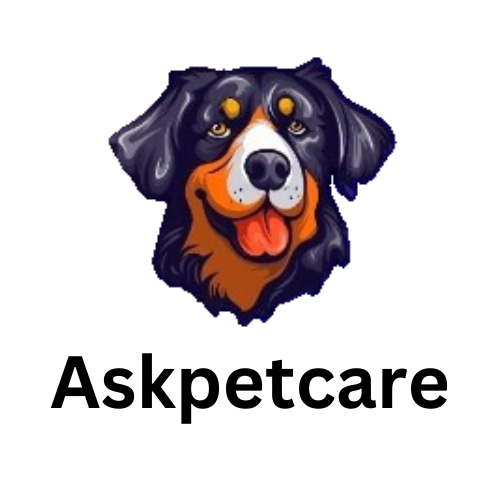Hello, dog lovers today’s topic is Flea allergy dermatitis in German Shepherd treatment. In this, I will tell you different methods for the removal of fleas from your German shepherd.
Hello everyone who loves dogs! I’m Dr. Arif Aziz, and I’ve been taking care of pets especially dogs at my clinic for a long time, exactly 14 years! I’m here to share some valuable information with you that I’ve gathered from books during my study time written by experts in veterinary medicine (DVM) and MSC (Master of Science), as well as from my own experiences working with dogs.

Firstly understand what Flea allergy dermatitis (FAD) is:
Flea allergy dermatitis (FAD) is a specific type of allergic reaction that occurs in dogs when they are exposed to flea saliva. Flea saliva contains proteins that can trigger an immune response in some dogs, leading to allergic reactions. It’s not the bite itself that causes the reaction, but rather the proteins present in the saliva that enter the dog’s skin during the bite.
When a dog with FAD is bitten by a flea, the immune system reacts excessively to the flea saliva proteins. This immune response results in the release of inflammatory substances, such as histamines, which cause intense itching, redness, swelling, and irritation of the skin.
What are Fleas?
Fleas are tiny parasitic insects that feed on the blood of mammals and birds. They belong to the order Siphonaptera and are known for their jumping ability, which allows them to move quickly between hosts and across various surfaces. Fleas are external parasites that can infest pets such as dogs and cats, as well as humans.
These small, wingless insects have flattened bodies, strong legs for jumping, and mouthparts adapted for piercing the skin of their hosts and sucking blood. Fleas reproduce rapidly, with females laying hundreds of eggs in the fur of their host animals. The eggs then fall off into the environment, where they hatch into larvae and pupae before emerging as adult fleas.
Now Understand Different Methods for Treating Flea Allergy Dermatitis In German Shepherds:
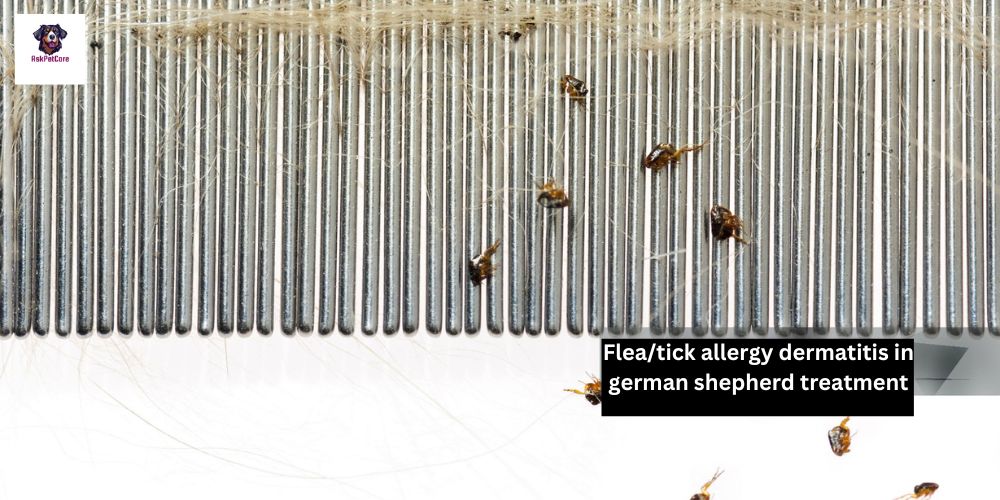
Firstly understand the General Approach:
A general approach means looking at the whole picture of a problem and using different methods to treat it. In the case of flea allergy dermatitis, a holistic approach combines regular treatments with natural methods like acupuncture, herbal remedies, or special supplements that can reduce inflammation in the skin.
For instance, acupuncture involves putting very thin needles into specific points on the body to help reduce pain and inflammation. Herbal remedies are natural plants or extracts that can be used to soothe the skin or boost the immune system. Dietary supplements are vitamins or special nutrients that can be added to your dog’s food to help improve their skin health and reduce allergic reactions.
By using these natural methods along with regular treatments, it’s believed that you can help your dog feel better and manage their flea allergy dermatitis more effectively. It’s like using a combination of traditional and alternative treatments to give your dog the best chance at feeling well again.
Now discuss the Alternative Therapies:
Alternative therapies are different ways of treating a problem without using traditional methods like medicine or surgery. In the case of flea allergy dermatitis, alternative therapies include treatments like phototherapy or laser treatment.
Phototherapy uses special lights to treat the skin. These lights can help reduce inflammation and itching caused by flea allergy dermatitis. It’s like giving your dog’s skin a special kind of light treatment to help it heal.
Laser treatment is another alternative therapy that uses focused beams of light to target specific areas of the skin affected by flea allergy dermatitis. The light energy from the laser can help reduce inflammation and promote healing in those areas.
These alternative therapies are different from regular treatments, but they can be helpful for some dogs with flea allergy dermatitis. They offer additional options for managing the condition and helping your dog feel better.
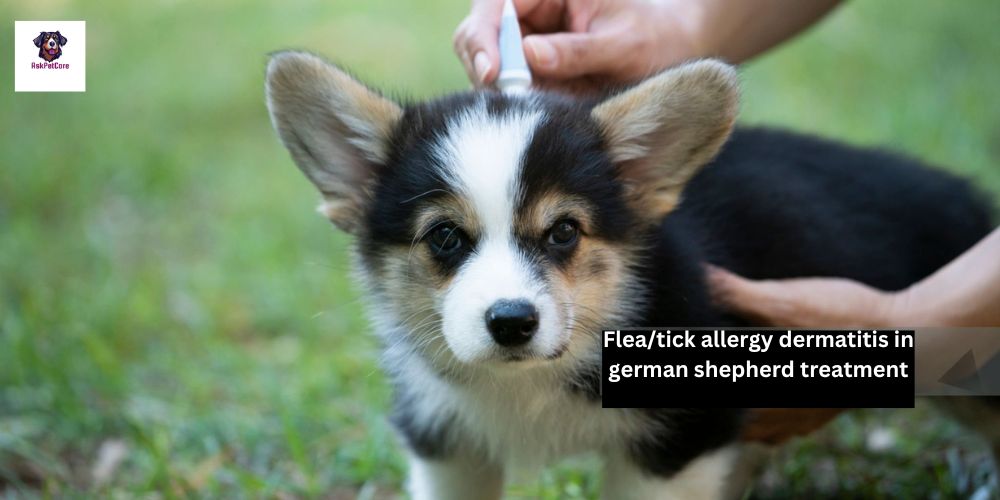
Now Discuss Hydrotherapy For flea Allergy Dermatitis in German Shepherd Treatment:
Hydrotherapy means using water to help your dog feel better. For flea allergy dermatitis, you can give your dog oatmeal baths or let them swim.
Oatmeal baths are made by mixing oatmeal with water. This mixture helps calm your dog’s skin and stops itching caused by flea allergy dermatitis. It’s like giving your dog’s skin a cozy bath to make it feel better.
Swimming can also help dogs with flea allergy dermatitis. Swimming in clean water washes away things that make your dog’s skin itch, like flea saliva. The water also cools and soothes the skin, making your dog feel better.
Oatmeal baths and swimming are natural ways to help your German Shepherd feel better if they have flea allergy dermatitis. They work well with other treatments to keep your dog comfortable.
Now understand the Allergen Identification:
Allergen identification means finding out what things are making your dog allergic. For flea allergy dermatitis, you can work with a vet who knows a lot about skin problems. Together, you figure out exactly what’s making your German Shepherd scratch so much.
Once you know what’s causing the itchiness, you can make a plan to treat it better. This might mean using special medicines or treatments that work against those things. You can also try to keep your dog away from those allergens to stop them from getting itchy again.
By finding out what’s causing flea allergy dermatitis in your German Shepherd, you can help them feel better and deal with their skin problem more effectively. It’s important to work closely with your vet to come up with the best plan for your dog.
Now discuss the Nutritional Involvement of Flea allergy dermatitis in German shepherd treatment:
Nutritional intervention means changing your dog’s diet to help improve their skin health and immune system. For flea allergy dermatitis, you can try feeding your dog a special diet that’s designed to make their skin better and boost their immune system.
This special diet might include new kinds of proteins or special formulas that are less likely to cause allergies. These can help with any food sensitivities that might be making your dog’s flea allergy dermatitis worse.
By changing your dog’s diet to one that supports their skin and immune system, you can help them feel better and manage their flea allergy dermatitis symptoms more effectively. It’s important to work with your vet to find the right diet for your dog’s specific needs.
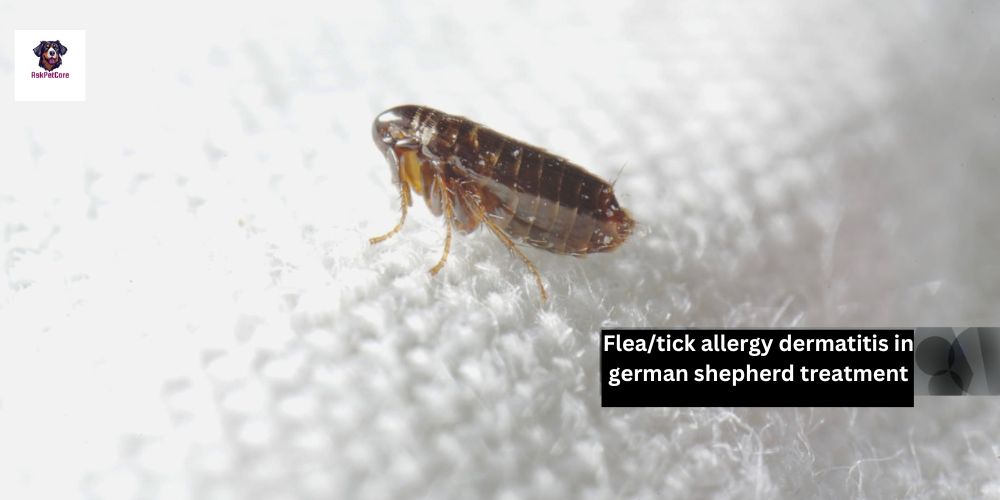
Now discuss the Environmental Improvement:
Environmental enrichment means making your German Shepherd’s surroundings more interesting and enjoyable. For flea allergy dermatitis, you can do things to help reduce stress and make your dog happier in their environment.
You can provide activities that stimulate their mind, like puzzle toys or games that encourage problem-solving. This keeps them busy and engaged, which can help distract them from any discomfort caused by flea allergy dermatitis.
Now discuss the Immune Variation for Flea allergy dermatitis in German shepherd treatment:
Immune modulation means adjusting how your dog’s body reacts to things that cause allergies. For flea allergy dermatitis, you can try treatments that help change your German Shepherd’s immune system response to flea allergens.
One option is using therapies that help control your dog’s immune system reaction to allergens. Another option involves gradually exposing your dog to small amounts of flea allergens to help their body get used to them and reduce allergic reactions over time.
These treatments are personalized to fit your dog’s specific needs and immune response to flea allergens. Over time, they can help lessen allergic reactions and make your dog feel better.
By trying immune modulation treatments and allergy desensitization protocols, you can help your German Shepherd manage flea allergy dermatitis more comfortably. It’s important to work closely with your vet to find the best treatment plan for your dog.
Now understand the Behavioral Modification:
Behavioral modification means helping your dog learn new habits to deal with flea allergy dermatitis better. For example, you can try techniques to stop your German Shepherd from scratching, licking, or chewing too much because of the itching caused by flea allergy dermatitis.
You can distract your dog with toys or games when you see them scratching or licking a lot. This helps them focus on something else and can stop them from scratching.
Playing with interactive toys or solving puzzles can also keep your dog busy and stop them from thinking about the itching.
Training exercises can teach your dog to do other things instead of scratching or licking, like sitting quietly when they feel itchy.
By using these techniques, you can help your German Shepherd feel better with flea allergy dermatitis and reduce how much they scratch or lick. It’s important to be patient and keep trying these methods to help your dog. Working with a dog trainer can also make it easier to teach your dog new behaviors.
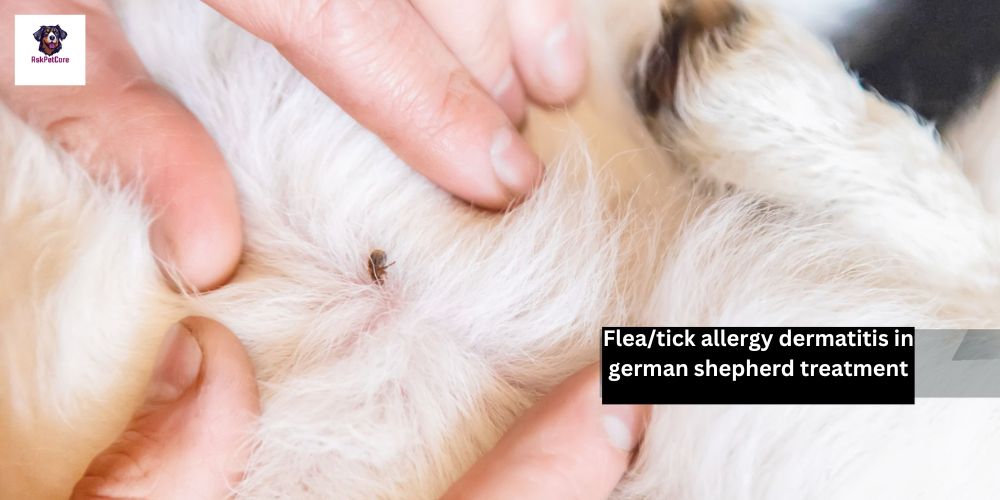
Now understand the Natural Remedies:
Natural remedies are simple treatments made from things found in nature. For flea allergy dermatitis, you can try using things like coconut oil, aloe vera, or colloidal oatmeal on your dog’s skin to help it feel better and heal.
Coconut oil: is a gentle oil that can soothe your dog’s irritated skin and help it feel less itchy.
Aloe vera: is a plant that has cooling properties and can help reduce inflammation and itching on your dog’s skin.
Colloidal oatmeal: is finely ground oats that you can mix with water to make a paste. It can help calm down irritated skin and make your dog feel more comfortable.
Apple Cider Vinegar: Diluted apple cider vinegar can be applied topically to your dog’s skin to help relieve itching and soothe irritated areas. It has anti-inflammatory properties and can also help balance the pH of your dog’s skin.
Chamomile Tea: Chamomile tea can be brewed and cooled, then applied to your dog’s skin using a clean cloth or cotton ball. Chamomile has calming and anti-inflammatory properties that can help reduce itching and irritation.
Tea Tree Oil: Diluted tea tree oil can be used as a topical treatment for flea allergy dermatitis. It has natural antiseptic and anti-inflammatory properties that can help soothe irritated skin and prevent infection. However, it’s important to use tea tree oil very sparingly and always dilute it properly, as it can be toxic to dogs if ingested or applied in high concentrations.
These natural remedies can be applied directly to the areas of your dog’s skin that are affected by flea allergy dermatitis. They’re gentle and don’t contain harsh chemicals or medications, which can be helpful for some dogs.
By trying natural remedies like coconut oil, aloe vera, or colloidal oatmeal, you can help soothe your dog’s irritated skin and promote healing without using strong chemicals. Always make sure to check with your vet before trying any new treatments on your dog’s skin.
Before using any natural remedies on your dog, it’s essential to consult with your veterinarian to ensure they are safe and appropriate for your dog’s specific condition. Additionally, always perform a patch test on a small area of your dog’s skin before applying any new treatment more widely to check for any adverse reactions.
Certainly! Here’s a table summarizing the natural remedies for flea allergy dermatitis:
| Natural Remedy | Description |
| Coconut Oil | Gentle oil that soothes irritated skin and reduces itching. |
| Aloe Vera | Cooling plant that reduces inflammation and soothes itchy skin. |
| Colloidal Oatmeal | Finely ground oats mixed with water to create a soothing paste for irritated skin. |
| Apple Cider Vinegar | Diluted and applied topically to relieve itching and balance skin pH. |
| Chamomile Tea | Brewed, cooled, and applied topically to calm inflammation and reduce itching. |
| Tea Tree Oil | Diluted and used sparingly as a topical treatment for its antiseptic properties. Must be used with caution. |
These natural remedies can be applied topically to affected areas on your dog’s skin to help alleviate symptoms of flea allergy dermatitis. Always consult with your veterinarian before trying any new treatments, and perform a patch test to ensure your dog doesn’t have a negative reaction.

Now discuss the Long-Term Management:
Long-term management involves creating a plan with your vet to help your German Shepherd deal with flea allergy dermatitis over time. Here’s how you can do it:
Regular Check-ups: Schedule regular visits with your vet to keep an eye on your dog’s skin condition and adjust treatments as needed.
Preventive Measures: Use flea control products regularly to prevent flea infestations and allergic reactions. This can include flea collars, topical treatments, or oral medications.
Lifestyle Adjustments: Make changes to your dog’s environment to reduce exposure to allergens. Keep their bedding and living areas clean, and vacuum frequently to remove fleas and their eggs from your home.
Allergy Testing: Consider allergy testing to identify specific allergens that may be triggering your dog’s flea allergy dermatitis. This can help tailor treatments more effectively.
Dietary Management: Feed your dog a balanced diet that supports skin health and boosts their immune system. Your vet can recommend specific diets or supplements that may help.
Stress Reduction: Minimize stress in your dog’s life, as stress can worsen allergic reactions. Provide a calm and stable environment and offer plenty of mental and physical stimulation.
By working closely with your vet and following a comprehensive management plan, you can help control flea allergy dermatitis and improve your German Shepherd’s quality of life in the long term. Regular monitoring and preventive measures are key to managing the condition effectively and minimizing its impact on your dog.
Now understand the different Preventive Measures:
Preventive measures involve using products to stop flea problems before they start. For flea allergy dermatitis, it’s crucial to keep fleas away from your dog. Here’s how:
Flea Collars: These are special collars that contain chemicals to repel fleas. They’re worn around your dog’s neck and help keep fleas away from their skin.
Topical Treatments: These are liquids that you apply directly to your dog’s skin, usually between their shoulder blades. They contain chemicals that kill fleas and prevent new ones from jumping on your dog.
Oral Medications: These are pills or chewable tablets that your dog eats. They contain chemicals that kill fleas when they bite your dog.
Using these preventive measures regularly helps keep fleas away from your dog and prevents allergic reactions caused by flea bites. It’s important to talk to your vet about which preventive measures are best for your dog and to follow their instructions carefully.
Flea Collars: These collars are designed with chemicals that repel fleas. They’re worn around your dog’s neck and help prevent fleas from coming close to their skin.
Here are brief descriptions of each flea collar:
Seresto Flea and Tick Collar for Dogs: Offers long-lasting protection against fleas and ticks, providing up to 8 months of continuous coverage.
Bayer Seresto Flea and Tick Collar: Provides effective flea and tick control for up to 8 months, with a water-resistant design suitable for dogs of all sizes.
Adams Flea and Tick Collar for Dogs and Puppies: Offers protection against fleas and ticks for up to 7 months, designed for dogs and puppies 12 weeks of age and older.
Hartz UltraGuard Flea & Tick Collar for Dogs: Kills and repels fleas and ticks for up to 7 months, with a water-resistant formula suitable for dogs of all sizes and breeds.
Scalibor Protector Band for Dogs: Provides up to 6 months of protection against fleas and ticks, offering a convenient and easy-to-use collar design for dogs of all ages and sizes.

Topical Treatments:
These are liquids that you apply directly to your dog’s skin, usually between their shoulder blades. They contain chemicals that kill fleas and prevent new ones from jumping on your dog.
Here are five examples of topical treatments for flea control along with brief descriptions:
Advantage II for Dogs: Advantage II is a monthly topical treatment that kills fleas at all life stages, preventing further infestations. It also kills flea larvae in the dog’s surroundings, breaking the flea life cycle.
Frontline Plus for Dogs: Frontline Plus is a waterproof topical treatment that kills fleas, ticks, and chewing lice. It provides long-lasting protection for up to 30 days and is safe for use on puppies and dogs over 8 weeks old.
K9 Advantix II for Dogs: K9 Advantix II is a topical treatment that repels and kills fleas, ticks, and mosquitoes. It also prevents flea eggs from developing into adult fleas, effectively breaking the flea life cycle.
Bio Spot Active Care Spot On Flea & Tick Drops for Dogs: Bio Spot Active Care is a monthly topical treatment that kills fleas, ticks, flea eggs, and flea larvae. It provides waterproof protection and is suitable for dogs and puppies over 12 weeks old.
Revolution for Dogs: Revolution is a topical treatment that protects against fleas, heartworms, ear mites, and other parasites. It also helps control sarcoptic mange and prevents flea eggs from hatching, providing comprehensive protection for your dog.
Here’s a simple table summarizing the topical treatments for flea control:
| Topical Treatment | Description |
| Advantage II for Dogs | Monthly treatment that kills fleas at all life stages and prevents further infestations. |
| Frontline Plus for Dogs | Waterproof treatment that kills fleas, ticks, and chewing lice, providing up to 30 days of protection. |
| K9 Advantix II for Dogs | Repels and kills fleas, ticks, and mosquitoes, preventing flea eggs from developing into adult fleas. |
| Bio Spot Active Care Spot On Drops | Monthly treatment that kills fleas, ticks, flea eggs, and larvae, suitable for dogs over 12 weeks old. |
| Revolution for Dogs | Protects against fleas, heartworms, ear mites, and other parasites, preventing flea eggs from hatching. |
These topical treatments are applied directly to your dog’s skin, typically between their shoulder blades, to effectively control fleas and other parasites. Always consult with your veterinarian to determine the best treatment option for your dog’s specific needs.
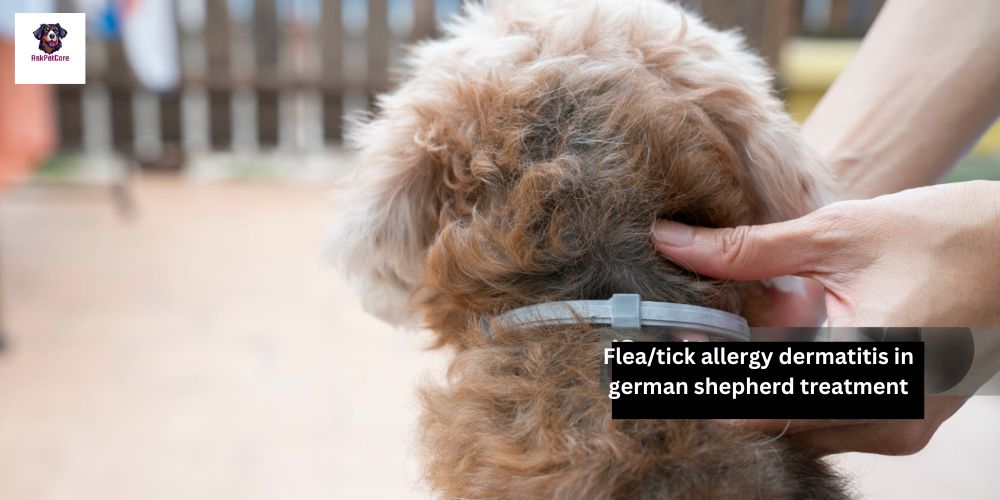
Oral Medications:
These are pills or chewable tablets that your dog eats. They contain chemicals that kill fleas when they bite your dog.
Here are five examples of oral medications for flea control, along with brief descriptions:
Bravecto: Bravecto is an oral chewable tablet that provides long-lasting protection against fleas and ticks for up to 12 weeks. It starts killing fleas within 2 hours and ticks within 12 hours after administration.
NexGard: NexGard is a chewable tablet that kills fleas and ticks quickly, with visible results within 8 hours of administration. It provides monthly protection against fleas and ticks for dogs.
Simparica: Simparica is an oral tablet that provides fast-acting and long-lasting protection against fleas and ticks. It starts killing fleas within 3 hours and ticks within 8 hours, with monthly dosing.
Trifexis: Trifexis is a monthly chewable tablet that protects dogs against fleas, heartworms, roundworms, hookworms, and whipworms. It starts killing fleas within 30 minutes and prevents heartworm disease.
Comfortis: Comfortis is a chewable tablet that provides month-long protection against fleas. It starts killing fleas within 30 minutes and is available for dogs and cats.
These oral medications are easy to administer and provide effective flea control for your dog. Always consult with your veterinarian to determine the best treatment option for your dog’s specific needs.
Here’s a simple table summarizing the oral medications for flea control:
| Oral Medication | Description |
| Bravecto | Long-lasting chewable tablet providing up to 12 weeks of protection against fleas and ticks, with rapid killing action. |
| NexGard | The monthly chewable tablet kills fleas and ticks quickly, providing visible results within 8 hours of administration. |
| Simparica | Fast-acting tablet providing month-long protection against fleas and ticks, with visible results within hours of administration. |
| Trifexis | Monthly chewable tablet protecting against fleas, heartworms, and intestinal parasites, with rapid flea-killing action. |
| Comfortis | Monthly chewable tablet providing flea control within 30 minutes, available for dogs and cats. |
These oral medications are designed to be easy for your dog to take and offer effective flea control. Always consult with your veterinarian to determine the most suitable option for your dog’s needs.

I hope you will thoroughly understand about the Flea allergy dermatitis in German Shepherd treatment, still, any quarry contact me.
- What are common symptoms of flea and tick allergy dermatitis in German Shepherds?
- Symptoms may include itching, redness, hair loss, and skin irritation, often concentrated around the ears, tail base, and groin area.
- What treatment options are available for flea and tick allergy dermatitis in German Shepherds?
- Treatment may include flea control measures, topical or oral medications to relieve itching, and addressing any secondary skin infections.
- How can flea and tick prevention help manage allergy dermatitis in German Shepherds?
- Preventing fleas and ticks can reduce allergic reactions, minimize itching, and prevent further skin irritation.
- Are there specific shampoos or topical treatments recommended for managing flea and tick allergy dermatitis in German Shepherds?
- Some medicated shampoos and topical treatments containing soothing ingredients can help alleviate symptoms and improve skin health.
- What role does diet play in managing flea and tick allergy dermatitis in German Shepherds?
- Providing a balanced diet with essential nutrients can support skin health and immune function, potentially reducing the severity of allergic reactions.
Here are some reference books that are considered authoritative on the topic:
These books cover a range of topics related to dermatology and skin diseases in dogs, including diagnosis, treatment, and management of skin conditions.
- “Muller and Kirk’s Small Animal Dermatology” by William H. Miller Jr. DVM DACVD, Craig E. Griffin DVM DACVD, Karen L. Campbell DVM DACVD :
- “Skin Diseases of the Dog and Cat” by Nicole A. Heinrich DVM DACVD, Melissa Eisenschenk DVM DACVD – :
- “Canine and Feline Dermatology Drug Handbook” by Sandra N. Koch DVM MS DACVD, Cheryl S. Hedlund DVM MS DACVD :
Disclaimer: This information is general advice only. Before starting any treatment or supplement with your pet, please consult your vet first for the best approach to getting your pet back to its best health.
Check with your veterinarian before giving any medication or supplement at home, to be sure it’s safe for your pup. Some substances can be toxic or harmful, including “dog-safe” medications and supplements if they are given at the wrong dosage.
